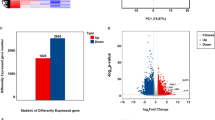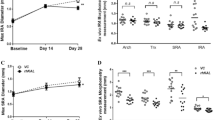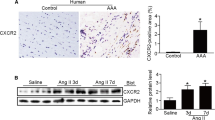Abstract
Purpose
P-selectin glycoprotein ligand-1 (PSGL-1) acts as a crucial regulator for the inflammatory cells infiltration by mediating the adhesion of leukocytes. However, the role of PSGL-1 in aortic aneurysm remains elusive. Here, we investigated the role of PSGL-1 in aortic aneurysm (AA) development.
Methods
We first detected PSGL-1 expression in samples from aortic aneurysm patients and mouse AA models via western blotting, immunofluorescence, and flow cytometry, and then we used global PSGL-1 knockout mice and their wild type controls to establish an aortic aneurysm model induced by deoxycorticosterone acetate (DOCA) plus high salt (HS). The incidence, fatality rates, and the pathological changes of aortic aneurysm were analyzed in each group. The inflammation, adhesion molecules expression, and PSGL-1 mediated leukocyte–endothelial adhesion and their underlying mechanisms were explored further.
Results
Increased PSGL-1 levels were observed in human and mouse aortic aneurysm, and on leukocytes of mice treated with DOCA+HS. PSGL-1 deficiency reduced the incidence and severity of aortic aneurysm significantly, as well as decreased elastin fragmentation, collagen accumulation, and smooth muscle cells degeneration. Mechanistically, the protective effect of PSGL-1 inhibition was mediated by the reduced adhesion molecules, and the subsequently reduced leukocyte–endothelial adhesion through the NF-κB pathway, which finally led to reduced inflammatory cells infiltration and decreased inflammatory factors expression.
Conclusion
PSGL-1 deficiency is protective against inflammatory cells migration and recruitment in the condition of AA through attenuation of leukocyte–endothelial adhesion. Inhibition of PSGL-1 may be a potential therapeutic target for the prevention and treatment of human AA.








Similar content being viewed by others
Data Availability
All data involved in this study are available from the corresponding author upon reasonable request.
References
Nordon IM, Hinchliffe RJ, Loftus IM, Thompson MM. Pathophysiology and epidemiology of abdominal aortic aneurysms. Nat Rev Cardiol. 2011;8(2):92–102.
Raaz U, Zollner AM, Schellinger IN, et al. Segmental aortic stiffening contributes to experimental abdominal aortic aneurysm development. Circulation. 2015;131(20):1783–95.
Golledge J. Abdominal aortic aneurysm: update on pathogenesis and medical treatments. Nat Rev Cardiol. 2019;16(4):225–42.
Davis FM, Daugherty A, Lu HS. Updates of recent aortic aneurysm research. Arterioscler Thromb Vasc Biol. 2019;39(3):e83–90.
Wang YD, Liu ZJ, Ren J, Xiang MX. Pharmacological therapy of abdominal aortic aneurysm: an update. Curr Vasc Pharmacol. 2018;16(2):114–24.
Patelis N, Moris D, Schizas D, et al. Animal models in the research of abdominal aortic aneurysms development. Physiol Res. 2017;66(6):899–915.
Wang Q, Ding Y, Song P, et al. Tryptophan-derived 3-hydroxyanthranilic acid contributes to angiotensin II-induced abdominal aortic aneurysm formation in mice in vivo. Circulation. 2017;136(23):2271–83.
Li DY, Busch A, Jin H, et al. H19 induces abdominal aortic aneurysm development and progression. Circulation. 2018;138(15):1551–68.
Manning MW, Cassis LA, Daugherty A. Differential effects of doxycycline, a broad-spectrum matrix metalloproteinase inhibitor, on angiotensin II-induced atherosclerosis and abdominal aortic aneurysms. Arterioscler Thromb Vasc Biol. 2003;23(3):483–8.
Liu S, Gong MC, Guo ZA. New mouse model for introduction of aortic aneurysm by implantation of deoxycorticosterone acetate pellets or aldosterone infusion in the presence of high salt. Methods Mol Biol. 2017;1614:155–63.
Liu S, Xie Z, Daugherty A, et al. Mineralocorticoid receptor agonists induce mouse aortic aneurysm formation and rupture in the presence of high salt. Arterioscler Thromb Vasc Biol. 2013;33(7):1568–79.
Chen HZ, Wang F, Gao P, et al. Age-associated Sirtuin 1 reduction in vascular smooth muscle links vascular senescence and inflammation to abdominal aortic aneurysm. Circ Res. 2016;119(10):1076–88.
Carlow DA, Gossens K, Naus S, et al. PSGL-1 function in immunity and steady state homeostasis. Immunol Rev. 2009;230(1):75–96.
Huo Y, Xia L. P-selectin glycoprotein ligand-1 plays a crucial role in the selective recruitment of leukocytes into the atherosclerotic arterial wall. Trends Cardiovasc Med. 2009;19(4):140–5.
Phillips JW, Barringhaus KG, Sanders JM, et al. Single injection of P-selectin or P-selectin glycoprotein ligand-1 monoclonal antibody blocks neointima formation after arterial injury in apolipoprotein E-deficient mice. Circulation. 2003;107(17):2244–9.
An G, Wang H, Tang R, et al. P-selectin glycoprotein ligand-1 is highly expressed on Ly-6Chi monocytes and a major determinant for Ly-6Chi monocyte recruitment to sites of atherosclerosis in mice. Circulation. 2008;117(25):3227–37.
Yang Y, Liu X, Liu Y, et al. The development of salt-sensitive hypertension regulated by PSGL-1 gene in mice. Cell Biosci. 2018;8:20.
Samadzadeh KM, Chun KC, Nguyen AT, et al. Monocyte activity is linked with abdominal aortic aneurysm diameter. J Surg Res. 2014;190(1):328–34.
Jiang X, Liu X, Liu X, et al. Low-dose aspirin treatment attenuates male rat salt-sensitive hypertension via platelet cyclooxygenase 1 and complement cascade pathway. J Am Heart Assoc. 2020;9(1):e013470.
Wu X, Zhang H, Qi W, et al. Nicotine promotes atherosclerosis via ROS-NLRP3-mediated endothelial cell pyroptosis. Cell Death Dis. 2018;9(2):171.
Hannawa KK, Cho BS, Sinha I, et al. Attenuation of experimental aortic aneurysm formation in P-selectin knockout mice. Ann N Y Acad Sci. 2006;1085:353–9.
Frenette PS, Denis CV, Weiss L, et al. P-selectin glycoprotein ligand 1 (PSGL-1) is expressed on platelets and can mediate platelet-endothelial interactions in vivo. J Exp Med. 2000;191(8):1413–22.
Hansen KB, Arzani A, Shadden SC. Mechanical platelet activation potential in abdominal aortic aneurysms. J Biomech Eng. 2015;137(4):041005.
Li H, Bai S, Ao Q, et al. Modulation of immune-inflammatory responses in abdominal aortic aneurysm: emerging molecular targets. J Immunol Res. 2018;2018:7213760.
Kroller-Schon S, Jansen T, Tran TLP, et al. Endothelial alpha1AMPK modulates angiotensin II-mediated vascular inflammation and dysfunction. Basic Res Cardiol. 2019;114(2):8.
Russo HM, Wickenheiser KJ, Luo W, et al. P-selectin glycoprotein ligand-1 regulates adhesive properties of the endothelium and leukocyte trafficking into adipose tissue. Circ Res. 2010;107(3):388–97.
Kitamura K, Sato K, Sawabe M, Yoshida M, Hagiwara N. P-selectin glycoprotein ligand-1 (PSGL-1) expressing CD4 T cells contribute plaque instability in acute coronary syndrome. Circ J. 2018;82(8):2128–35.
Sato C, Shikata K, Hirota D, et al. P-selectin glycoprotein ligand-1 deficiency is protective against obesity-related insulin resistance. Diabetes. 2011;60(1):189–99.
Terada Y, Ueda S, Hamada K, et al. Aldosterone stimulates nuclear factor-kappa B activity and transcription of intercellular adhesion molecule-1 and connective tissue growth factor in rat mesangial cells via serum- and glucocorticoid-inducible protein kinase-1. Clin Exp Nephrol. 2012;16(1):81–8.
Nanba K, Vaidya A, Williams GH, et al. Age-related autonomous aldosteronism. Circulation. 2017;136(4):347–55.
Davel AP, Jaffe IZ, Tostes RC, Jaisser F, Belin de Chantemele EJ. New roles of aldosterone and mineralocorticoid receptors in cardiovascular disease: translational and sex-specific effects. Am J Physiol Heart Circ Physiol. 2018;315(4):H989–H99.
Wang Q, Wang H, Wang J, et al. Angiotensin II-induced hypertension is reduced by deficiency of P-selectin glycoprotein ligand-1. Sci Rep. 2018;8(1):3223.
Lysgaard Poulsen J, Stubbe J, Lindholt JS. Animal models used to explore abdominal aortic aneurysms: a systematic review. Eur J Vasc Endovasc Surg. 2016;52(4):487–99.
Constantin G. PSGL-1 as a novel therapeutic target. Drug News Perspect. 2004;17(9):579–86.
Raffort J, Lareyre F, Clement M, et al. Monocytes and macrophages in abdominal aortic aneurysm. Nat Rev Cardiol. 2017;14(8):457–71.
Schumacher A, Liebers U, John M, et al. P-selectin glycoprotein ligand-1 (PSGL-1) is up-regulated on leucocytes from patients with chronic obstructive pulmonary disease. Clin Exp Immunol. 2005;142(2):370–6.
Yang TM, Lin YJ, Tsai NW, et al. The prognostic value of serial leukocyte adhesion molecules in post-aneurysmal subarachnoid hemorrhage. Clin Chim Acta. 2012;413(3–4):411–6.
Knight JS, Meng H, Coit P, et al. Activated signature of antiphospholipid syndrome neutrophils reveals potential therapeutic target. JCI Insight. 2017;2(18):e93897.
Dang B, Wiehler S, Patel KD. Increased PSGL-1 expression on granulocytes from allergic-asthmatic subjects results in enhanced leukocyte recruitment under flow conditions. J Leukoc Biol. 2002;72(4):702–10.
McEver RP. Adhesive interactions of leukocytes, platelets, and the vessel wall during hemostasis and inflammation. Thromb Haemost. 2001;86(3):746–56.
Patel MS, Miranda-Nieves D, Chen J, Haller CA, Chaikof EL. Targeting P-selectin glycoprotein ligand-1/P-selectin interactions as a novel therapy for metabolic syndrome. Transl Res. 2017;183:1–13.
Funding
This work was supported by grants from the Chinese Academy of Medical Sciences Innovation Fund for Medical Sciences (CIFMS, 2016-I2M-1-016, 2019-I2M-1-001); National Natural Science Foundation of China (81800402, 81670387); Fundamental Research Funds for the Central Universities (3332018107); and Life science society consortium “Youth Talent Promotion Project.”
Author information
Authors and Affiliations
Contributions
Zhiwei Yang and Xianxian Wu designed the study. Xianxian Wu, Xing Liu, Hang Yang, Qianlong Chen, Na Zhang, Yuhan Li, Xingchen Du, Xue Liu, and Xiaoliang Jiang carried out data acquisition and analysis. Xianxian Wu and Zhiwei Yang wrote the paper. Yideng Jiang and Zhou Zhou supervised the study. All authors reviewed the manuscript.
Corresponding authors
Ethics declarations
Conflict of Interest
The authors declare that they have no conflicts of interest.
Ethical Approval
All applicable international, national, and/or institutional guidelines for the care and use of animals were followed.
Additional information
Publisher’s Note
Springer Nature remains neutral with regard to jurisdictional claims in published maps and institutional affiliations.
Supplementary Information
ESM 1
(DOCX 26445 kb)
Rights and permissions
About this article
Cite this article
Wu, X., Liu, X., Yang, H. et al. P-Selectin Glycoprotein Ligand-1 Deficiency Protects Against Aortic Aneurysm Formation Induced by DOCA Plus Salt. Cardiovasc Drugs Ther 36, 31–44 (2022). https://doi.org/10.1007/s10557-020-07135-1
Accepted:
Published:
Issue Date:
DOI: https://doi.org/10.1007/s10557-020-07135-1




